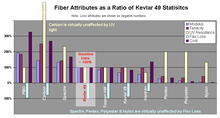Talk:Sailcloth
| This article is rated Start-class on Wikipedia's content assessment scale. It is of interest to the following WikiProjects: | ||||||||
| ||||||||
Fix the chart
The chart showing properties of various materials is suspect. First off, it mentions Spectre, whereas the article later gives the correct Honeywell trade name of Spectra. Also, it lists the tensile modulus of Zylon as exceeding that of carbon. According to Matweb.com, Zylon fibers have a modulus of 180 GPa, but (for instance) AS4 fibers (other carbon fibers are stiffer) the stiffness is 228 GPa. --Hermanoere (talk) 17:17, 17 February 2010 (UTC)
Self-contradictory
[edit]The sentences in the following paragraph seem all to be disjointed, and in some places it doesn't make sense.
- Doek is Dutch for cloth, which was evolved into the English word "duck" in reference to sail canvas.
Why is it in this order, with the meaning of the Dutch word and the "duck" rather than discussing sailcloth?
- Duck was typically made from cotton or linen (flax), with some use of hemp. These natural fibers have poor resistance to rot, UV light and water absorption. Linen is stronger, but cotton is lighter. Linen was the traditional fiber of sails until it was supplanted by cotton during the 19th century.
but then it says
- At first cotton was used as a matter of necessity in the United States as it was indigenous and the supply of flax was periodically interrupted by wars such as the War of 1812, during which demand for sailcloth for military use was high. As sail size grew linen was too heavy to be practical so cotton became more popular. Cotton did not substantially replace linen worldwide until the end of the age of sail
and then it goes on to contradict itself yet again:
- however, in some cases the strength of linen was preferred for some types of sails. It was not until the late 20th century that natural fibers were replaced by synthetics in mainstream use.
After this we have
- Cotton sailcloth is still used for sportswear, upholstery and draperies.
How does this remotely relate to the above sentences?
- The traditional width for carded cotton sailcloth in the US was 23 inches (58 cm) while the British standard was 24 inches (61 cm).[1]
Again this seems like babbling, and it is unrelated to the rest of the paragraph.
NotYourFathersOldsmobile (talk) 06:46, 9 February 2016 (UTC)
Source(s) of image data?
[edit]
@Kevin Murray: It would be helpful to know the source(s) of the data in the image that you provided, comparing different fibers. We can use it (them) to provide references in the itemized sections. Cheers, HopsonRoad (talk) 13:17, 24 January 2020 (UTC)
Hi, This was researched and written many years ago (12-13), and under a lower expectation of in line citation etc. at WP. I think much of the data for the chart is/was at the WP articles for the fibers. I remember that there were some great 3rd party sources online, and maybe I linked the bibliography to what are now defunct pages, and the links went dead. Ugh! A question that I have is how much technology has changed in over a decade +. I love this chart as a quick visual to put the options in perspective. But the specific numbers may be obsolete.
I don't write much for WP anymore it's gotten too complex. But I do think that there is an overemphasis on the inline citations, and these have become tools to manipulate POV. We worry too much that there is a citation and not enough about the quality and neutrality of the source. Not so much in sailing, but in general. Best of luck to you! --Kevin Murray (talk) 17:55, 16 February 2020 (UTC)
Lead section
[edit]@Mr. Guye recently added a Lead too short tag, but it is not obvious what further information they think might make the lead better or why they didn't improve it themself. Anybody any good ideas? --- Frans Fowler (talk) 02:13, 20 November 2023 (UTC)
- Thanks for following up on this Frans. I suggest that, if each major section has a summary sentence in the lead, that should suffice! Cheers, HopsonRoad (talk) 21:56, 21 November 2023 (UTC)
- Thanks, but I am removing the tag now. The whole article is substantially about what sailcloth is made from, and how. That is what the lead already summarises. ---- Frans Fowler (talk) 23:56, 29 November 2023 (UTC)


